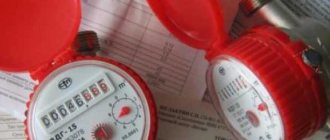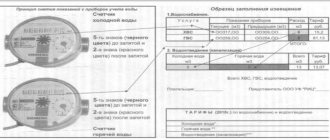Electricity meters are an integral attribute of any electrical network. They keep records of energy consumption, based on the results of which payments are made to the electricity supplier. Therefore, any operation of any equipment and devices in an apartment building, private house or outbuilding without a meter is prohibited. Like any measuring instruments, electric meters have a certain service life and mandatory verification, which establishes the measurement error.
Types of meters
The first devices for metering consumed electrical energy (electricity meters) appeared at the end of the nineteenth century. These were rather bulky devices with low accuracy and large dimensions. When the operation of meters was based on the principle of electromagnetic induction, the devices became structurally simpler, weight and dimensions decreased, and accuracy increased.
Such electricity meters operating on this principle are called inductive meters. Until recently, they were the most common devices for metering consumed electrical energy.
When an electric current passes through the inductors located in this meter, an inductive electromagnetic field is created. This field causes the metal disk to rotate. The greater the passing current, the more intense the electromagnetic field, the faster the disk rotates. The amount of electricity consumed is calculated by the number of revolutions of this disk.
Until recently, one of the most common counters was SO I446. Thanks to its simple design, it has a long service life, but it also has a number of disadvantages. These are: low accuracy class 2.5, low protection from external interference and an increase in reading error at low loads.
It was replaced by a new induction meter - CO M505. It already has an accuracy class of 2.0, and its service life is 32 years.
In addition to induction-type devices, electronic meters have recently found increasing use. Their big advantage is high accuracy. Due to the absence of mechanical moving parts in the design, a long service life of at least 25 years is ensured. Such electricity meters can be multifunctional and programmable. For example, keep track of energy consumption at several tariffs: day and night. However, due to their high price, it is advisable to install them only in industrial and office premises.
Electronic devices usually have an LCD digital display, and some models allow metering data to be taken remotely. It should be noted that, in addition to single-phase electricity meters, there are three-phase measuring devices. They are installed where there is a three-phase electrical line necessary to power the equipment: industrial and commercial premises, office buildings and the like.
Electricity metering devices also differ in accuracy class. According to the latest rules, for apartments and private houses, a device with an accuracy class of at least 2.0 (2% error) is sufficient.
The electricity meter located at the entrance to an apartment building must already have an accuracy class of 1.0. There are also more accurate devices of class 1.0, but they are no longer used for home purposes, but for industrial purposes.
Calibration intervals and replacement periods
Each electric meter model has its own test interval, noted in its technical data sheet. It begins to be calculated from the moment the device is put into operation, and not from the time of purchase or date of manufacture.
On each meter with the expiration date indicated on it. For single-phase devices it is 2 years, and for three-phase devices it is 1 year. If during this period of time the device has not begun to be used, then without performing a new verification it cannot be used for accounting. In all apartments and private houses, representatives of the service organization inspect the meters every six months, and in other facilities - every year.
However, sooner or later the time comes when, during the next inspection, it turns out that the electric meter is no longer capable of performing its functions. Many people begin to remember the service life of the meter and quickly decide when to change the electric meter. As a rule, the total period of operation of the device by this time is 16 years. In addition, the reason for replacement may be an unexpected failure of the device, which is detected by the subscriber himself. The device is dismantled and sent to the metrology service for examination for possible further use.
Currently, widespread replacement and installation of new equipment is being carried out, even if the current meter has not been completed by the established inspection date. This measure was initiated by a special government resolution, which requires the installation of metering devices with an accuracy class of at least 2.0.
In addition, all electricity meters with obvious mechanical damage, broken glass, or a faulty counting mechanism must be replaced. Meters that have been declared invalid by the regulatory authority are being replaced due to discrepancies between the readings of the actual electricity consumed. A new device is installed instead of the old one and in case of the user’s personal desire to switch to a multi-tariff mode.
After removing the old meter, a special tariff will be used for electricity calculations for this period. The maximum period from the installation of a new device to its sealing is set at one month.
Is there an expiration date
Due to the simplicity of their design, the service life of induction meters is quite long and is at least 30 years, and for electronic metering devices at least 25 years. The exact service life is indicated in the manufacturer's passport for the product. During this time, the meters are checked to confirm their serviceability and the veracity of the readings.
But there are some details you should know. Devices with accuracy classes 1.0 and 2.0 have an average shelf life of 16 years from the date of commissioning. Please note that the period is calculated not from the moment of manufacture, but from the moment the measuring device is turned on. Devices with accuracy class 2.5 are used until the verification period has expired. This means that the operation of such a device is allowed until the error measurement carried out by the metrological service exceeds the permissible threshold.
The verification date is indicated in the passport for the measuring device. In addition, metrological services can verify the device at the request of the consumer if there are suspicions that its readings are inaccurate. Organizations serving electrical networks also have the right, if necessary, to verify electricity meters. If, as a result of verification, the error exceeds the permissible threshold, the metering device must be replaced.
Causes
There are several situations in which electric meters must be replaced. Let's look at a number of them.
- If work is underway to repair or update your home network.
- In case of visual defects, breakdowns, short circuits, or incorrect equipment settings.
- If the device is “outdated”, including morally, including the expiration date.
The replacement for legal entities is especially worthwhile:
- With a maximum power of 670 kilowatts, the device must comply with accuracy class 1.0 and higher.
- For power consumption above 670 kilowatts, the device must have an accuracy of 0.55 or better. Moreover, it must store data on energy consumption for the last three months.
To directly replace an electric meter, a citizen should contact:
- to the management company,
- to specialists or organizations carrying out electrical work,
- private electricians,
- for private sector residents, contact an organization that maintains electrical networks,
- perform the replacement yourself.
At this point you should be extremely careful; it is better to have a specialized education. After replacement, the citizen is issued a certificate of replacement of the device. In case of independent replacement, a certificate of putting the device into operation is drawn up. Moreover, it is often necessary to show the old meter for a control check.
How to make a replacement
When the service life of an electricity meter has expired, or it has not passed routine verification, it is necessary to replace it.
If this device is located in a privatized apartment or in a private house, then it is considered the property of the owner of the premises. In this case, all costs for its verification and replacement are borne by the home owner.
If the metering device is located outside the residential premises, for example, on a staircase landing, the costs of this work are borne by the electricity supplier.
In the first case, it is necessary to write an application to the organization that provides the supply of electricity in the approved form. Although the work itself is not technically difficult and can be done independently, it is necessary to invite a specialist from a service organization. This is explained by the need to seal the meter and register it.
General requirements for the installation of electricity meters
All electricity metering devices, regardless of their installation location, are subject to the same requirements. When installing an electric meter in an apartment or private house, the necessary conditions must be provided. For these purposes, a dry and heated room is selected, in which the air temperature ranges from +1 to +40 degrees. There are no aggressive particles or components in the air that could affect the accuracy of the device.
A rigid surface is used for mounting the meters, and they themselves are installed vertically, eliminating the possibility of vibrations, deformations and other mechanical damage. It is allowed to use metal, plastic or wooden boards as surfaces.
The height of the device from the floor level is on average 0.8-1.7 m. In case of emergency, this parameter can be reduced to 0.4 m. The electric meter is provided with free access for maintenance, replacement and reading.
Stage 2 – Acquisition
Instead of the old electric meter, you need to find a new one. This issue and its solution should be dealt with by the one who must replace the electric meter by law:
- The owner of the apartment or house, if the housing is privatized;
- The owner of the meter, if the corresponding clause is specified in the agreement with the management company;
- Management company, if the housing is public, the meter is a common property of the house;
- Municipality, if the square meters are provided under a social rental agreement.
In the first two cases, all financial expenses, including the cost of the device, consumables, and payment for electrician calls, are borne by the apartment owner.
It is better to buy a new meter directly from the power supply company, having considered its technical characteristics in advance: the number of tariffs, the possibility of remote transmission of readings, connection method, service life, voltage class and withstand power.
Differences between induction and electronic equipment
Electric meters can be single- or three-phase and connected to the network using measuring current transformers or without them (indirect and direct connection). All meters currently used are divided into induction and electronic. Taking these features into account, it is determined what service life the electric meter of a given model should have.
The first option was initially used in all spheres of people's lives and activities. The installation of induction electricity meters stopped only in the mid-90s of the last century. Currently, they are still in use in large numbers and are considered serviceable. However, they are relegated to the category of legacy devices without multi-tariff metering support. In addition, these devices cannot transmit remotely acquired data.
The main advantage of induction devices is their low cost, compared to electronic devices. They are not affected by power surges and poor power quality. These electricity meters have a long service life and are considered very reliable.
Read more Water consumption rate per person per day snip
However, based on modern realities, these devices have significant drawbacks. First of all, they are distinguished by a low accuracy class, within 2.0, and an increase in error as the load decreases. Induction meters themselves consume a significant amount of electricity through voltage and current circuits. They are practically not protected from theft of electricity, cannot simultaneously take into account active and reactive energy, and have too large overall dimensions.
The main difference between electronic meters is microcircuits and the absence of any rotating parts. The signals coming from the measuring elements are converted electronically into power and energy with a proportional magnitude.
There is a higher accuracy and service life of the electric meter, so longer inter-check time intervals are established for them. They are equipped with a built-in digital interface and tarifficator.
Electronic meters are capable of simultaneously taking into account active and reactive electricity; they can be configured for single- or multi-tariff mode. Active energy is taken into account for each individual phase. All received readings are displayed on the liquid crystal display. If necessary, programming is carried out to operate in the required mode.
Stage 1 – Approval
Nothing can be changed without approval from network services, so the first steps should be the following:
- Contact the energy sales office, submit in person or send via mail an application for a replacement, indicating the address and reason for the replacement;
- Wait for an answer, check with the dispatcher about the electrician’s arrival time;
- Certify the malfunction of the device;
- Get permission to replace.
Read here! How to connect machines - do-it-yourself connection and installation instructions. Recommendations from experts + video
Important! If you notice a violation of the integrity of the seal, then immediately contact the control room, since concealing such a fact is punishable by administrative liability, court and a fine.






